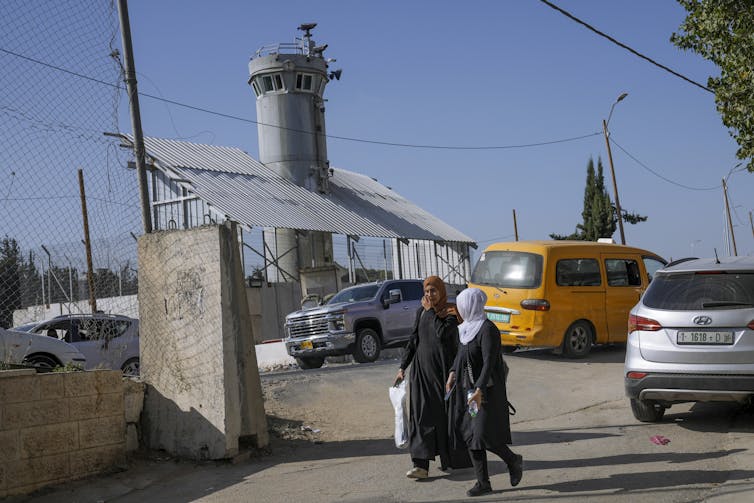
After the surprise Hamas terrorist attack on Israel from the Gaza Strip on Oct. 7, 2023, many observers were puzzled about how Israel could have been caught completely off-guard.
We were among those puzzled, and proposed three possible reasons:
- Israeli leaders may have underestimated Hamas’ capabilities and misunderstood its intentions.
- Israeli intelligence may have been tricked by Hamas’ secrecy, missing signs that it was planning and training.
- Israeli intelligence leaders may have been so wedded to their prior conclusion that Hamas was not a major threat that they dismissed mounting evidence that it was preparing for war.
New revelations from recent media coverage have shed additional light on what happened, which mostly confirm the role of faulty threat assessments, Hamas’ improved operational security, and confirmation bias.
An official assessment
On Oct. 29, The New York Times reported that since May 2021, Israel’s military intelligence leaders and National Security Council had officially assessed that “Hamas had no interest in launching an attack from Gaza that might invite a devastating response from Israel.”
As a result, Israeli Prime Minister Benjamin Netanyahu and security leaders diverted attention and resources away from Hamas and toward what they saw as more existential threats: Iran and Hezbollah. For instance, in 2021, the Israeli military cut personnel and funding for Unit 8200, a key military surveillance unit watching Gaza. In 2022, the unit stopped listening in on Hamas militants’ radio communications, though it apparently gathered other intelligence.
The U.S. made a similar shift, focusing on the Islamic State group and other militants, leaving intelligence gathering on Hamas to Israel.
Revealing surveillance
Within days of Oct. 7, Egypt revealed that it had shared with Israel high-level warnings of impending Hamas violence – “something big.”
A Guardian report in early November revealed that Hamas leaders who had planned the attack took special measures to avoid being detected by Israeli intelligence, including passing orders only by word of mouth, rather than by radio or internet communication. But Hamas’ planning did not totally escape detection.
The Times of Israel reported in late October that Israeli troops of the Combat Intelligence Corps surveilling the Israel-Gaza border months before Oct. 7 saw Hamas militants digging holes, placing explosives, training frequently and even practicing blowing up a mock fence. Their warnings were ignored. The Financial Times reported in early November that Israeli security leaders had also ignored specific alerts of Hamas training exercises from civilian volunteers in southern Israel who eavesdropped on Hamas communications.
The Financial Times also reported that weeks before the Hamas attack, Israeli border guards sent a classified warning to the top military intelligence officer in the southern command. They had detected a high-ranking Hamas military commander overseeing rehearsals of hostage-taking and warned that Hamas was training to imminently “blow up border posts at several locations, enter Israeli territory and take over kibbutzim.” The officer who received the message dismissed it as an “imaginary scenario.” Other leaders considered the warning unremarkable.
A detailed plan
On Nov. 30, The New York Times reported that Israeli intelligence obtained a detailed Hamas plan of attack more than a year before Oct. 7. The plan ran to 40 pages and included specifics that actually were part of the attack, including an opening rocket barrage, drones knocking out security cameras and automated weapons at the border, and gunmen crossing into Israel in paragliders as well as on foot and by motorcycle.
The newspaper also reported that in July 2023, a Unit 8200 analyst observed Hamas training activities that lined up with the Hamas plan, which was code-named “Jericho Wall” by Israeli officials. The analyst determined that Hamas was preparing an attack designed to provoke a war with Israel. Superior officers dismissed her assessment, saying the “Jericho Wall” plan was only aspirational primarily because they thought Hamas lacked the capacity to carry it out.

A reflection on the Israeli intelligence community
These recent reports make clear that Israeli officials had enough intelligence to step up security. The fact that they did not suggests they may have dismissed all that evidence in favor of other information they had, which suggested Hamas was not interested in or capable of going to war with Israel.
But that may not have been the only problem. Recent studies point to increasing fissures in civil-military relations in Israel. For example, populist right-wing Israeli politicians in recent years have viewed senior intelligence officials with skepticism as potential leftist rivals, which could have led Netanyahu’s Likud government to be hostile to alternative viewpoints and various intelligence warnings on Hamas.
Although we cannot observe the extent of politicization among the senior Israeli intelligence ranks, the behavior of intelligence leaders who dismissed warnings prior to Oct. 7 is consistent with groupthink, a phenomenon that experts say may occur when social pressure, a leader’s influential position or self-censorship leads groups to express homogeneous views and make uniform – and usually poorer – decisions.
The fact that superiors ignored warnings from the Unit 8200 analyst and the Border Defense Corps is consistent with the idea that groupthink about Hamas’ capabilities and intentions led to confirmation bias dismissing Hamas as an imminent threat.
Some of the ignored intelligence analysts were young women, who have said they believe sexism could have been a reason male superiors ignored their warnings.
Another form of prejudice may also have been at play. Israel has focused intensely on its technological advantages over its enemies, assigning large numbers of personnel to electronic and cyber warfare units. Perhaps technological optimism, faith in what the Financial Times described as “aerial drones that eavesdrop on Gaza and the sensor-equipped fence that surrounds the strip,” won out. Maybe a reliance on technology led to a false sense of security, and even the dismissal of other forms of intelligence that, it turned out, had uncovered Hamas’ real plans.
A turn toward the future
In the wake of the Hamas attacks, Israel’s security apparatus will need to investigate these weaknesses further and undertake reforms. So far, it remains unclear how many people, and at what levels of the Israeli government, received the various warnings in advance of Oct. 7. Therefore, it’s not yet clear what specific changes in Israel might prevent a similar failure in the future.
The authors do not work for, consult, own shares in or receive funding from any company or organisation that would benefit from this article, and have disclosed no relevant affiliations beyond their academic appointment.
This article was originally published on The Conversation. Read the original article.







